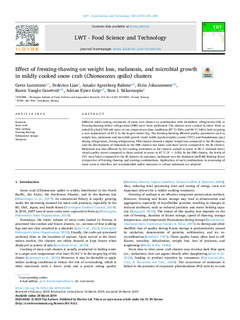| dc.contributor.author | Lorentzen, Grete Elisabeth | |
| dc.contributor.author | Lian, Federico | |
| dc.contributor.author | Røhme, Amalie Agersborg | |
| dc.contributor.author | Johannessen, Eirin | |
| dc.contributor.author | Grastveit, Karen Vanglo | |
| dc.contributor.author | Grip, Adrian Eyser | |
| dc.contributor.author | Siikavuopio, Sten Ivar | |
| dc.date.accessioned | 2020-01-30T12:30:46Z | |
| dc.date.available | 2020-01-30T12:30:46Z | |
| dc.date.created | 2019-06-12T10:04:24Z | |
| dc.date.issued | 2019 | |
| dc.identifier.citation | Lebensmittel-Wissenschaft + Technologie. 2019, 108 283-288. | nb_NO |
| dc.identifier.issn | 0023-6438 | |
| dc.identifier.uri | http://hdl.handle.net/11250/2638877 | |
| dc.description.abstract | Different mild cooking treatments of snow crab clusters in combination with immediate refrigeration (IR) or freezing-thawing before refrigeration (FBR) have been performed. The clusters were cooked in either fresh or salted (5 g NaCl/100 ml) water at two temperature/time conditions (87 °C/430 s and 96 °C/148 s) both targeting a core temperature of 81 °C in the largest cluster leg. The freezing-thawing affected quality parameters such as weight loss, melanosis and microbial growth (total viable psychrotrophic counts (TVC) and Pseudomonas spp.) during refrigeration. During refrigeration, FBR clusters showed a higher weight loss compared to the IR clusters, and the development of melanosis in the FBR clusters was faster and more severe compared to the IR clusters. Melanosis was also affected by the cooking treatments as the clusters cooked in water at 96 °C obtained better visual quality scores compared to those cooked in water at 87 °C (P < 0.05). In the FBR clusters, the levels of TVC were lower compared to the IR clusters. In summary, melanosis was the dominant shelf-life limiting factor irrespective of freezing-thawing and cooking combinations. Application of such combinations in processing of snow crabs is therefore not recommended unless measures to reduce melanosis are adopted. | nb_NO |
| dc.language.iso | eng | nb_NO |
| dc.publisher | Elsevier | nb_NO |
| dc.rights | Navngivelse 4.0 Internasjonal | * |
| dc.rights.uri | http://creativecommons.org/licenses/by/4.0/deed.no | * |
| dc.title | Effect of freezing-thawing on weight loss, melanosis, and microbial growth in mildly cooked snow crab (Chionoecetes opilio) clusters | nb_NO |
| dc.type | Journal article | nb_NO |
| dc.type | Peer reviewed | nb_NO |
| dc.description.version | publishedVersion | nb_NO |
| dc.source.pagenumber | 283-288 | nb_NO |
| dc.source.volume | 108 | nb_NO |
| dc.source.journal | Lebensmittel-Wissenschaft + Technologie | nb_NO |
| dc.identifier.doi | 10.1016/j.lwt.2019.03.083 | |
| dc.identifier.cristin | 1704222 | |
| dc.relation.project | Norges forskningsråd: 267763 | nb_NO |
| dc.relation.project | Nofima AS: 11928 | nb_NO |
| dc.description.localcode | © 2019 The Authors. Published by Elsevier Ltd. This is an open access article under the CC BY license (http://creativecommons.org/licenses/BY/4.0/).T | nb_NO |
| cristin.unitcode | 194,66,15,0 | |
| cristin.unitname | Institutt for bioteknologi og matvitenskap | |
| cristin.ispublished | true | |
| cristin.fulltext | preprint | |
| cristin.qualitycode | 1 | |

